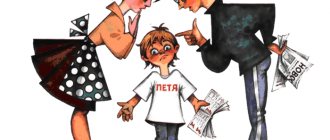Psychology of the collective (page 1 of 4)
Topic 1.6. PSYCHOLOGY OF RELATIONS IN TRADING COLLECTIVES
Topic: Psychology of the collective
1.
The concept of “group” and “team”.
2.
Leadership styles
2.1.
Positive and negative features of different leadership styles
2.2.
Standards of conduct for a leader
3. Formal and informal structures of the team
(independently)
1. The concept of “group” and “team”
A person lives, develops and acts in a certain community of people, that is, a group.
In the team and under its influence, the formation of personality is carried out - its orientation, social activity, will are formed, conditions are created for self-regulation and the development of abilities. However, not every community of people to which an individual belongs can be called a collective. It is necessary to distinguish between the concepts of “group” and “collective”.
A group can be called any association of people, regardless of the nature of the connections that exist between its members.
Groups can be large and small, real and conditional, official and unofficial and referent.
Real groups
- these are associations of people based on real relationships - business or personal. Thus, a real group is a classroom, a family, a group of friends, etc.
Conditional group
unites people according to some conventional characteristic - age, gender, nationality. Members of a conditional group do not have real relationships and connections with each other and may not even know each other.
Official (formal) group
arises as a structural unit on the basis of staff regulations, instructions and other documents. Formal ones are student groups, families, military units, and production teams. Business relations between its members are determined by the official responsibilities of each and are regulated by a specific manager.
Unofficial group
is a community of people that arose spontaneously on the basis of the common interests of its members, sympathies, unity of views and beliefs, or for other reasons. Thus, unofficial groups are groups of people who are friends, lovers of fishing, tourism, etc.
Reference (standard) group
- this is a really existing or conditional group, the views, norms and values of which are a model for the individual, under its influence she forms her life ideals, directs her own actions and actions.
Uniting people into real groups can be based on common activities determined by the unity of needs, interests, and the desire to achieve significant results.
The highest form of group organization is the collective.
A team is an organized association of people who jointly solve common and, moreover, socially significant problems.
Each team member is interested in achieving a common goal. In addition to common tasks, each member of the team solves personal tasks in the process of joint activity, which may be close to the general ones, be independent of them, or be in conflict with them.
2. Leadership styles
At the head of each group is a leader - the organizer of group activities, the bearer and guardian of group norms. The leader can be nominated from among the members of an already established group or from the very beginning. A leader is a person who enjoys the recognized authority of the group and for whom the group recognizes the right to make decisions about actions in important situations, to be the organizer of the group’s activities and to regulate relationships in it.
Each team always has its own leader, organizer.
There are different types of leaders depending on how they carry out their tasks in a group.
Authoritarian – personal activity, energy predominates, suppression of the initiative of group members, i.e. group unity is established on the basis of the subordination of all to one.
Democratic – he is not so noticeable in the group. Through his actions, he contributes to the growth of activity and initiative of each group member.
The remaining members of the group play more or less defined roles in it. The position that is assigned to each participant determines his position in the group, i.e. so-called status. Depending on how the roles are distributed and what the statuses of individual group members are, the general psychological climate and well-being of individual group members and, ultimately, the success of joint activities depend.
Another factor influencing the nature and results of a group’s (team’s) activity is its focus—how common the group goal is for all group members.
Any norms that have become collective are subsequently instilled in each newcomer. And the less the newcomer’s own life experience, the narrower his horizons, the more absolute and binding the internal foundations of his first team will be for him. The better the preliminary preparation, the higher a person’s own culture, the more opportunities he has to correctly assess the environment in which he finds himself, and the more responsibly he will build his relationships with it. Formal management and leadership are different forms of team management.
Leadership
is a process of influencing people generated by a system of informal relations, and
leadership
implies, first of all, the presence of clearly structured formal (official) relations through which it is regulated.
The problem of leadership and management is associated with different styles of carrying out this activity.
Leadership style
is
the way a leader behaves towards subordinates; These are forms and methods of managing a team and an individual.
Each person is unique, therefore, as many leaders as there are, there are as many leadership styles. However, in the behavior of managers one can observe certain typical traits that have varying degrees of expression. This serves as the basis for identifying different types of leaders. They can be reduced to two opposites: democratic and autocratic (authoritarian).
An authoritarian view of enterprise management and, accordingly, team management leads to direct regulation and strict control, while a democratic view supports the delegation of authority and responsibility.
In its “pure” form it is hardly possible to observe the manifestation of any style. It is more correct to talk about the inclination of a particular leader either towards democratic or autocratic leadership, depending on the extent to which certain characteristics are expressed in the behavior of a given individual.
The simplest and most popular typology of individual leadership styles was developed by K. Levin back in the 30s. He reduces all leadership styles to three main types: authoritarian, democratic and permissive (liberal).
Authoritarian leadership
characterized by a high degree of personal power of the leader. The autocrat “knows everything himself” and does not tolerate objections. Provides subordinates with only a minimum of information. Doesn't trust anyone, doesn't let anyone know about his intentions; gives businesslike, brief instructions; prohibitions are often accompanied by threats. Praising and blaming employees is highly subjective. The emotions of subordinates and colleagues are not taken into account. Work in the team is planned in advance in its entirety; only immediate goals for each employee are determined. The leader's voice is decisive, and his position is outside the group.
A leader who adheres to this style certainly craves people’s subordination to his will, does not tolerate objections and does not listen to other opinions, often interferes in the work of subordinates and strictly controls their actions, and demands punctual adherence to his instructions. He cannot stand criticism and does not admit his mistakes, but he himself loves to criticize. He is of the opinion that administrative penalties are the best way to influence subordinates. He works a lot, forces others to work, including after school hours. Can take risks, but prudently. He demands from his subordinates whatever he considers necessary, regardless of the fact that his demands often go beyond the scope of his official duties and lead to violations of labor laws. Tends to dominate public organizations and turn them into simple executors of his will.
When communicating with people, he is sometimes impatient, or even rude, but not necessarily. He can be benevolent, correct, listen carefully and publicly weigh the ideas of subordinates, but neglect their opinion when making the final decision, so that in this case the style essentially remains directive. In general, an autocratic leader is characterized by a lack of respect for others.
In practice, the authoritarian style in such a characteristic form is quite rare. Moreover, the techniques and methods of work inherent in an autocrat can evoke sympathy and respect due to the prompt solution of problems.
It is worth noting that in the minds of other subordinates, an autocrat is also a leader who reasonably acts according to a clear plan and implements it despite all obstacles.
In this case, he can be tough, but not cruel, uncompromising, but fair, powerful, but not overwhelming, decisive, but not self-confident. However, for the most part, leaders of the autocratic type have insufficiently developed such attractive personal qualities, but the desire to command and achieve unquestioning obedience prevails.
The manager's desire for unity of command cannot, ultimately, cause any objections, since this is one of the fundamental principles of management. K. Marx said “... an individual violinist controls himself, an orchestra needs a conductor...”.
But being a sole manager does not mean deciding all issues yourself.
Psychology and Human Life (A. E. Sokolov, 2015)
Chapter IV
Psychology of the collective
A team is a community of at least two people interacting with each other, creating common principles of relationship. In a team, the psychological climate depends to a large extent on the leader, who must take into account the psychophysiological characteristics of each member of the team and be well aware of their characteristics during interaction. The strengthening of the team is facilitated by the fair distribution of labor results and rewards among its members, the competent distribution of responsibilities taking into account the qualifications of experience and attitude towards work. The basis of the strength and cementation of the team are: the diligence of its members, their culture of treatment, goodwill, mutual assistance, and the absence of gossip. At the same time, each team has its own characteristics, its own specifics. It is important that selfishly minded ill-wishers who are capable of taking more than they give in common work, with an evil disposition and other negative mental deviations do not gain the upper hand in the team, so that these negatives are dulled by positive emotions or, as psychologists emphasize, by a good psychological climate. The level of morality is a measure of the health of the team.
In order to skillfully and effectively manage a team, the manager must know well its social composition, working conditions, individual characteristics of each, and feel the overall psychological climate.
Historical experience has shown that people unite into a family, group, team, organization because each individual cannot satisfy their needs for a normal life process, which increase as society develops.
By uniting with interested individuals, people, through common efforts, effectively, through social work, more successfully solve individual problems. Practice has established that labor productivity increases when it is cooperated; in this case, the joint production of products and labor products is much cheaper. At the same time, we must not forget that social work lifts a person’s mood, creates a psychological climate, public mood, and more successfully suppresses negative moods.
Under certain conditions, the work collective, social labor, and the psychological mood of people can be the basis for the emergence of protest phenomena, disturbances, rallies, processions, struggles on the barricades... up to revolutions (if the common interests of people are unsatisfactorily resolved by leaders and higher management organizations).
In this way, the working people will seek to resolve the issues that have arisen, improve production and other relations, up to changing the social system.
Scientists have found that in work collectives, as a rule, both formal and informal relations exist simultaneously. Formal relations are established by the state, higher management bodies and heads of various levels of management through lawmaking, issuing by-laws, etc.
Informal relationships arise within a team, as a rule, on the initiative of informal leaders emerging from the environment of the team. Each manager - official, appointed or elected, who establishes production relations in the team, must strive to ensure that informal relations diverge as little as possible in their moods and aspirations from the administratively established relationships.
Standardization of behavior in a group of individuals, rational behavior of each person, active social, mutually interested life, strength and unity are the determining conditions for strengthening various work teams and society as a whole.
Openness of relationships, goals and objectives, and the actual state of affairs, as a rule, gives positive results in the approach, understanding and assessment of events in the work team. They are transmitted to people's relationships in other aspects of their lives.
The need for judgments, a real approach to understanding current events in society, increases with an increase in the level of literacy, culture, and specialization of a person. The social activity of an individual in a team largely depends on the organization of the social group. The emergence and establishment of an evaluative stereotype is influenced by: upbringing, education, personality traits, time of communication, profession, personal qualities of the “evaluator” himself, and the team. Often, undesirable situations arise in cases of inattention to the employee, disrespectful attitude towards him, or underestimation of his worth.
Life has shown that economic activity in a team is directly dependent on the moral atmosphere in it, on the formal leader who skillfully or ineptly fits into economic practice, which in each case gives different work results. The task is for managers, and each member of the team, to help him intelligently destroy personal problems, overcome self-doubt, and provide the necessary assistance to a person in an age of increasingly complex life.
Research has shown that people united in large production organizations, teams, with the same physical effort as in private (individual) work, produce much more products than alone or in a small team. This leads to the conclusion: to increase labor productivity, it is necessary to create large teams. This is on the one hand, and on the other hand, another feature arises: the unification of teams on a productive basis into concerns, departments, ministries is a necessary reasonable step in increasing the efficiency of this production. This leads to clear conclusions regarding improving the management of industries.
All enterprises, especially in such large states as Russia, should be united into ministries and departments. Only in such subordination can they successfully develop their production and improve their technology. It should be emphasized that under the auspices of a ministry or department only enterprises of one industry should be united, i.e. ministries should be sectoral in nature, promote the growth of production in each of them, improve technology, disseminate advanced labor methods, and take care of a decent life labor collective.
United under one superior body - the ministry, enterprises in a given branch of production have absolute preference in terms of existence than enterprises in private hands. In these cases, as the analysis has shown, in the same hands there are, as a rule, several enterprises and organizations from different branches of production, different areas of work that require competent, sectoral development, which a private owner cannot provide. For he does not have seven spans in his forehead. But hopes for market relations is a rather complex concept, and it is not worth interpreting it one-sidedly (resolving issues of pricing and sales of products). For large enterprises will always and everywhere, under any conditions, dictate to the market what they need.
Special mention should be made here about the psychology of private traders, especially “owners of enterprises, newspapers, ships,” as Mayakovsky said. Many of the private owners (large) have enterprises and organizations in different branches of industrial production, different areas of household and intellectual work. As has been established, at best, each of them is a specialist in only one branch of industrial production, in one direction of economic activity. In this case, will he have a better understanding of the economy and the development of enterprises in various sectors of activity that are in his ownership than, say, a specialized industry ministry or department? Of course not!!
And if so, then the question arises: in what structural subordination, in whose ownership will this enterprise better satisfy the interests of the people, which is its main purpose, and not the owner himself (everything is clear here: to take everything from life, because he “deserves” it) ). The answer involuntarily arises: property should be in the hands of the people (the state), and managed according to the sectoral principle. The time has come to take a closer look at what the market economy has provided, is it needed in this form?
The market economy does exist in various social formations in international trade, but in a socialist society pricing was directed in a different direction. And it was justified.
Taking into account human psychology, the psychology of the collective, the development and state of public opinion, all production organizations and their management bodies should be aimed at meeting the needs of the entire population, and not their individual owner, the entire population of the country! The whole people are interested in this.
It is more expedient to concentrate the ownership of the means of production and the distribution of production products, household and other services in the hands of the people, the government, which is pursuing a policy of meeting the needs of the country's population, and not the private owner.
After the so-called perestroika, as a result of which many ill-gotten enterprises and organizations of various kinds appeared from private owners, the capitalist path of economic development began to be implemented in Russia, as a result of which the absolute majority of the people do not see an improvement in their living conditions.
No amount of criticism from the past can correct the current situation. This can only be done if all government bodies and administrations critically evaluate the state of affairs existing in the country today, find violations and shortcomings primarily in the economy and strive to correct them, only then will public opinion be favorable to this and the affairs in the state will go uphill.
Human psychology is formed over generations. Social labor, social activity appeared in order to jointly, easier and more productively, ultimately solve the problems of the life of each person individually. This tendency lives to varying degrees in every person. If he is not limited, then in his actions he will strive more and more to solve his problems using the efforts and labor of others. This is an axiom that does not require proof.
That is why there are constitutions, laws, and, finally, economic and social policies in the state that determine the rights and opportunities in society for all categories of people. If a person is not limited in his rights, if the same standards of behavior are not made for everyone, he will strive to subjugate others and use them for personal interests. All social formations in the past existed on this principle, and the capitalist mode of production still exists today. But humanity strives for equality as its intellectual, cultural and living standards rise. This desire of the human community intensifies every year. Despite heroic efforts, the affirmation of capitalist society as an ideal by certain categories of people, this process of developing into a new formation of social relations will intensify. The preconditions for a new, fairer society for all are already being created.
According to N.A. Amosov, “it is impossible to quickly activate our society, since the pace depends on the biological characteristics of a person: training requires time and perseverance, as well as restoring the ideals, morality and authority of the leader.”[2] All existing media and other types of information should serve this, and not devote efforts for some selfish purposes. They are intended in society only to solve the above problem, to educate a person, to cement his social connections.
Freedom of opinions and judgments cannot hide the intentional and “accidental”, everywhere coinciding actions of the media, aimed, as luck would have it, at the decomposition, and not at the cementation of our society. This influence especially has an impact on the behavior of the so-called crowd, or rather, on the formation of it. Emotions take over in it, it actively influences a person who becomes part of the mass. The main source of information is rumor, usually aggressive, which often represents wishful thinking.
Every person in an organization is influenced by official leaders, administration, public organizations, and also at the same time, no less, by an informal group of which he himself is a member. If these influences do not contradict each other, then this means: in this team, unity in thoughts and actions triumphs - a good sign of the strength of relationships between individuals; it is able to fulfill the vital functions assigned to it to the fullest extent.
A leader of any rank, from the highest to the lowest, must strive to create in the subordinate team, in any organization, and in society and the state as a whole, the above-mentioned position, which will be the key to the successful political, economic and social development of peoples.
The team as a socio-psychological phenomenon. Signs, functions and conditions for team development
People have long strived for collective activity, as it is the most effective. In the dynamics of the group process, various professional and educational tasks are solved with fairly high effectiveness. But is this always possible? What is a collective and how does it influence the individual?
A team is a group of people united by common goals and objectives, which has achieved a high level of development in the process of joint activities. The most important feature of a team is socially significant goals and objectives. This is a complex structural formation with numerous external and internal connections. The mechanism of external relations includes the impact on the collective of society as a whole, as well as the specific organization in which it is included. The mechanism of internal connections consists of informal and formal interpersonal relationships. Formal connections are determined by the relevant instructions and job responsibilities of each team member, informal connections are determined by the psychological relationships between people.
Depending on the field of activity, there are:
— professional teams;
— public organizations;
- voluntary societies;
- amateur groups.
The team goes through certain stages of development:
The first stage is characterized by the collective’s struggle for self-affirmation. This period is characterized by a contradiction between the interests of the collective and the individual himself.
The second stage begins when the collective becomes an objective condition for the comprehensive development of the individual. Now the main goal of the team is the development, satisfaction and enrichment of the normal interests of each individual, the process of mutual enrichment of individuals in the course of various affairs and relationships.
The main functions of the team.
The team has the following functions:
1. Familiarization with the system of social relations and the organization of their accumulation of experience in these relations.
2. The team acts as the main form of organization of activities: educational, labor, social, gaming.
3. The entire complex of interpersonal, business, friendly, and emotional relationships forms the moral essence of the individual.
Factors influencing team work.
1. Group size – the number of people included in the team.
2. The composition of the group, understood as the similarity of personalities and points of view, the approaches that they show in solving problems.
3. Group norms - certain rules of the group that either promote or hinder the achievement of the goals of the group.
4. Group cohesion is a measure of the attraction of group members to each other and the group itself.
5. Group unanimity is the tendency for an individual to suppress his actual views on some phenomenon, so as not to disturb the harmony of the group.
6. Conflict: differences in opinions often lead to higher group effectiveness, but conflict can also greatly complicate task completion and generally lead to the destruction of group interaction.
7. Status of group members: Group members whose status is high enough are able to exert great influence on the group's decision.
8. Roles of group members. For a team to function more effectively, its members must behave in ways that promote the achievement of its goals and social interaction.
The psychological climate has a special influence on the development of the team.
Psychological climate of the team
in a certain sense, it is an integral characteristic of his psychology; it reflects interpersonal relationships, moods, opinions and traditions of the team.
For a favorable psychological climate in a team, a special type of interpersonal relationship is required, which is characterized by:
1) high cohesion ;
2) collectivist, self-determination as opposed to conformity or non-conformity, manifested in groups of a low level of development;
3) collectivist integration;
4) the socially valuable nature of the motivation for interpersonal choices;
5) high referentiality of team members in relation to each other;
6) high objectivity in assigning and accepting responsibility for the results of joint activities.
It should be noted that in the process of communication and interaction of people in a team, mutual influence of the individual and the team occurs. The team has the following impact:
- it introduces the individual to moral, ideological, aesthetic and other values;
- it performs an educational function;
- influences the personality due to its corrective function (through public opinion, persuasion, explanation, criticism, competition).
The influence of an individual on a team is expressed in his authority and leadership.
Thus, a team is a group of people united by common goals, subordinate to the goals of society and which is of great importance for human life.
Text of the book “Psychology of Physical Culture. Textbook"
Chapter 6 Psychology of a sports team
6.1.
The concept and characteristics of a sports team Sports activity is collective in nature and takes place in specific conditions - in the conditions of a sports team. A sports team is a team with relationships that develop within it. A sports team faces certain tasks: a) training and education of athletes; b) improving the sportsmanship of its members; c) agitation and promotion of sports; d) involving people in sports; e) protection of the sporting honor of the organization at various competitions.
A sports team as an established team has the following characteristics:
Autonomy –
conscious isolation from the environment, which is achieved by the existence of restrictions on the number of members, the presence of group goals, common values, rules, traditions, etc.
Cohesion
characterized by the presence of strong relationships between team members and the manifestation of a sense of “We”.
Group-wide goal
sports team – achieving high personal and team results. It is the commonality of purpose that characterizes a sports team.
Collectivism –
the most valuable quality of a sports team. Each member of the team subordinates personal goals to socially significant ones.
The position and role of each team member is determined by sports preparedness and a number of personal qualities that manifest themselves in relation to sports activities, team members, things and the surrounding reality.
Differentiation and structure.
The interaction of team members in the process of solving problems gives rise to differentiation between its members according to the functions performed and personal contacts. The second characteristic is structure, which involves the creation of connections and relationships between athletes and individual groups within the team.
Stability
composition of a sports team for a long time.
6.2.
Structure of a sports team Structure refers to stable relationships between the elements of an integral object. In a sports team, relationships take two forms—interpersonal interactions and interpersonal relationships.
Interpersonal interactions are objective connections between people in a group, determined by the specifics of the sport. For a sports team, these are mainly motor interactions and informational ones, carried out using speech, gestures, signals, etc. Both of these types of interactions exist together. The type of sport determines the nature of interactions.
Interpersonal interactions are about people's attitudes. There are many relationships that are established for a sports team. Primary relationships include business and personal.
Business relationships are included in and determined by joint activities. Together with interpersonal interactions, they form the formal structure of the team. It is determined by the distribution of functions between participants in activities, training, and competition. Each athlete must interact with others in the manner prescribed to him.
Interpersonal relationships are subjective connections between team members. They are determined by the personal factor. These relationships express the active, selective position of the individual and form the informal structure of the team.
The elements of the team structure are the athletes - members of this team. Communicating and acting, athletes form many subgroups:
1. The competition composition includes the most prepared athletes. In different sports, this subgroup is divided into links (defenders and attackers; relay starters and finishers, etc.).
2. The training staff includes all team members. Members of this group do not always take part in competitions.
3. Informal groups are formed on the basis of sympathy and common interests.
There can be several informal groups in a team. 6.3.
Dynamic processes in a team 1. Norms and group pressure.
Norms of human behavior in a group represent established or required standards in activity and communication. The assimilation of these norms and traditions is necessary for normal group activity.
The tendency of a person to change his behavior under the influence of other people so that it corresponds to the opinions of others, the desire to adapt it to their requirements is called conformity. The opposite concept is independence, independence.
It is important for a coach or teacher to know that by insisting on obeying his demands, which may be unacceptable for their students, he will have to deal with the following consequences:
a) the athlete continues to defend his point of view, does not show conformity, and the conflict becomes more complicated;
b) the athlete outwardly accepts the demands of the group, but in fact continues to resist them;
c) the athlete changes his opinion and assimilates the opinion of the majority, agrees with authority not because he was convinced, but out of fear of being left alone;
d) the athlete resists pressure, denying all group standards and demands, demonstrating supposed independence.
2. Leadership in a sports team.
In the system of interpersonal relations, one of its members is nominated, who takes on the functions of informal leadership of the group. This is the leader.
The differences between leadership and management are as follows:
a) the leader emerges spontaneously in the sphere of interpersonal relations; the manager is appointed;
b) the leader exercises leadership based on the norms accepted in this group; the activities of the leader are regulated by the laws, rules, and instructions established in society;
c) the manager, unlike the leader, has at his disposal a certain system of various official sanctions;
d) leadership largely depends on the mood of the group; management is more stable;
e) the leader’s sphere of activity is limited to a small group; the leader represents the group in the wider social sphere.
Depending on the role played, there are two types of leaders:
a) business, whose actions are aimed primarily at solving the tasks assigned to the team;
b) an emotional leader whose actions are focused on interpersonal relationships. In sports practice, a combination of these actions is possible for one person.
The phenomenon of leadership is explained by the following theories:
• “Trait theory” – a leader becomes one who has certain qualities necessary to fulfill the role of a leader.
• “Situational theory of leadership.” According to this theory, the leader becomes the member of the team who is superior to others in a given specific situation.
• “Synthetic theory of leadership.” Leadership is viewed in it as a process of organizing interpersonal relationships in a group, and the leader is considered as a subject of managing this process.
3. Group decision-making process.
As the team's level of sportsmanship increases, the system of interpersonal relationships becomes more complex and the role of decisions made by the team, asset, and coach increases. Group decisions are often more effective than individual decisions.
Collegial decisions have their advantages:
a) they are more rational and less subjective;
b) the group principle of decision-making is more democratic;
c) group members, when making decisions, share responsibility for them;
d) the likelihood of the decision being implemented increases.
When a group makes decisions, the following forms are used: group discussion, brainstorming, synectics method (combining heterogeneous things). These forms are widely used in the pre-competition preparation of gaming teams.
The quality of group decisions can be reduced if the group develops relationships in which special importance is attached to group unity, a good atmosphere, and self-satisfaction to the detriment of a real assessment of the position in the group. Group decisions in such groups are characterized by the following:
a) conformism dominates in the group;
b) biased selection of information for decision-making;
c) unreasonable optimism;
d) belief in the omnipotence of the group;
e) deceptiveness of initiative.
To prevent such phenomena, the group leader (trainer) should create an organization of joint activities that stimulates the critical thinking of each group member.
4. Development of a sports team.
Development is the process of transforming an association of people into a small group (team). A psychological community emerges from individuals who are unfamiliar with each other. The development of the group is characterized by:
– personal enrichment; a person, participating in group life, acquires for himself or discovers something new and valuable in himself;
– increasing the efficiency of joint activities;
– increasing the satisfaction of group members with participation in group life;
– differentiation of the activities of group members and relationships between them;
– integration of interactions and relationships among group members, ensuring its integrity.
A developed sports team is characterized by cohesion, compatibility, teamwork, and a favorable psychological climate.
5. Unity
– is the formation of unity of interpersonal relationships in a group. It is based on the closeness of group members’ relationships to group values. The attractiveness of the team and dedication to its values serve as a source of additional motivation for the athletes and make them want to give all their strength to fight.
6. Triggerability
- this is a harmonious, effective interaction of group members in the conditions of specific joint activities.
A sign of a well-organized group is an optimal pace of work, high productivity, accuracy and consistency of actions, and mutual understanding. 6.4.
Compatibility and teamwork in sports activities Group compatibility is a broad concept that includes various interpersonal relationships:
1) complementarity of needs - when two individuals complement each other. For example, when one individual shows a strong desire for leadership, and another shows a need for obedience;
2) congruence of needs - when two individuals have similar needs, and these needs are mutually satisfied by the same interpersonal relationship. For example, when both feel a strong need for intimacy or, conversely, a need for autonomy;
3) complementarity of skills - when the insufficient abilities of one individual are compensated by the high abilities of another;
4) complementarity of knowledge - when two individuals have “non-overlapping” knowledge, so that each can learn from the other or rely on the competence of the other;
5) community of values - when two or more individuals have a common system of values and rules of behavior.
The formation of optimal relationships and the effectiveness of joint activities in sports are determined by three types of compatibility: social, psychological and psychophysiological. However, you should not understand this absolutely, that is, think that compatibility should be maximally expressed at all three levels (types). Full compatibility presupposes the optimal combination of all its types and the presence of a certain relationship between them, their complementarity and interchangeability. Sports activity is characterized by situations where one or the other type of compatibility comes to the fore, becomes leading and determines the effectiveness of joint activities. The significance of this or that type of compatibility is determined by the characteristics of sports activity, its “scenario”, requirements, and objectives. The presence of compatibility between members of group activities leads to workability. Indicators of teamwork are: a) the productivity of joint activities and the nature of behavior of group members; b) emotional and energy costs, manifested in physiological indicators and subjective indicators of the state of satisfaction with work, with oneself, with a partner; c) features of mutual understanding of each other.
The importance of compatibility in the teamwork of sports groups is evidenced by the following facts: 1) the majority of tennis players who are winners in doubles have never been winners in singles; 2) crews (team rowing) made up of athletes who won single competitions are not always effective.
When studying compatibility in sports groups and their recruitment, one should proceed from the organization of joint activities. There are three types of organization of joint activities in sports:
1) consistently performed joint activities. This type of sports activity takes place in sports games (team and doubles);
2) synchronously performed joint activity (non-contact). It includes individual elements of figure skating, sports acrobatics, rhythmic gymnastics (team exercises), synchronized swimming, synchronized trampolining, team rowing;
3) simultaneously performed joint activities (contact). This type of activity takes place in sports acrobatics (pairs, triples, fours), individual elements in figure skating (lifts, throws).
Since each of these types has its own specific characteristics, the performance in them will be determined by its own set of factors, knowledge of which will allow the coach to more effectively staff sports groups. And what the complex of these factors is for each type of joint activity is a problem for sports psychology today.
Of particular importance in sports psychology is the compatibility of coaches when managing one sports team (hockey, basketball, volleyball, football, etc.). Based on an analysis of psychological literature and observations of the joint activities of coaches in managing sports teams, we have identified the factors that determine the success of their joint activities. In this regard, levels of compatibility are also distinguished (G. D. Babushkin, 2006).
• The first, highest level is socio-ideological. It assumes the unity of moral and ethical values, conviction, and patriotism. Since the elements of socio-ideological compatibility represent a core substructure of the personality, this level will be of primary importance in the hierarchy of trainer compatibility levels.
• The second, lower level of compatibility is socio-psychological, which provides for similarity of views, attitudes towards oneself, partner, team, as well as unity of opinions, interests, attitudes.
• The third level is psychological, suggesting similarity in some character traits (responsibility, preoccupation with business, anxiety, etc.) and complementarity in others (excitability, determination, calmness, etc.).
• The fourth level is psychophysiological, suggesting differences in age and temperament.
• The fifth level is professional, which provides for differences in the socio-psychological status that coaches occupy in leading the team.
In the system of compatibility levels, the upper ones, socio-ideological and socio-psychological, occupy a leading place in joint activities, can be regulated by the consciousness of trainers and controlled from the outside, that is, by management.
6.5.
Psychological features of sports team management The management of a sports team at the level of the formal structure is carried out by the coach, and at the level of the informal structure - by the leader. The leadership activities of a sports coach include the following functions:
– Informational,
consisting in the transfer of information to students. A coach, as a sports specialist, has a complex of knowledge necessary for athletes. However, coaches do not always convey information to athletes, which affects their theoretical preparedness. An athlete must know the features of a sports competition, the nature of pre-start states and the reasons for their occurrence and regulation, the mechanisms of motor skill formation, means of self-regulation and much more that a coach acquires in the process of professional training.
– Educational,
which consists in constantly training athletes in skills, development and improvement of physical and volitional qualities, and tactical techniques. A coach cannot always show athletes a new sports exercise, but he must perfectly know the technique of its execution and pass it on to his students.
– Educational,
which consists in the fact that the coach is an educator for his athletes, especially in the first stages of sports, when he plays the role of a guardian. The education of young athletes largely occurs through imitation of their coach. The effectiveness of the process of educating young athletes is determined by the education of the coach himself.
Leading –
manifests itself in the leadership of a team. The coach, as a team leader, is responsible for all members of the team assigned to him, for their sporting achievements, and for the results of participation in competitions.
Administrative –
consists of performing a number of administrative and economic duties: organizing and conducting sports training, training camps, competitions, searching for sports sponsors, providing the team with sports equipment.
6.6.
Managing communication in a team Behavior management comes down to predicting the behavior of an athlete in a certain situation and organizing this behavior in the right direction. Regulation of athletes’ communicative behavior can be carried out: 1) through direct control of behavior and communication, based on the specific requirements of the situation and interaction tasks; 2) indirectly through such forms of organizing joint activities that would necessarily lead to the desired interpersonal influences (Yu. L. Khanin, 1980).
Within the framework of these approaches, a coach or psychologist is faced with tasks of three levels: 1) intragroup (communication in a team in general, between many participants); 2) interpersonal (normalization of communication between two specific partners or several); 3) actually personal, or intrapsychic.
Direct management of team communication
. The first task of managing communication in a team is to remove or prevent aggressive reactions towards erring partners and to establish communication links between interacting players who, for various reasons, do not communicate in the game.
An aggressive reaction carries negative consequences. Simply prohibiting aggression has no effect. How to proceed here? In any attitude towards another person, three components are distinguished: 1) cognitive (assessment of his competence and business qualities), 2) emotional (liking or antipathy); 3) behavioral (a specific program of action and behavior in relation to a specific person). The most mobile and controllable is the behavioral component. To change the behavior of a particular person, it is necessary to offer him a certain (new) program of action.
Managing communication in a team includes the following aspects: 1) working with the team as a whole; 2) work with leaders; 3) work with followers.
1. Working with the team as a whole
. Initially, it is advisable to regulate communicative behavior through special instructions that orient all athletes towards the desired communication with instructions to actively communicate, express their feelings in moderation, help partners, and approve of others. It is necessary to regulate the direction of communication so that the connections coincide with the game connections and correspond to the logic and requirements of the interaction process.
2. Working with team leaders
. Often, leaders show incomprehensible passivity and become a source of conflicts and disorganization of collective actions. The reasons for this behavior may be:
– personal characteristics of these leaders (increased self-esteem, conflict, aggressiveness, excitability, etc.);
– lack of necessary communication skills;
– unfavorable business or interpersonal relationships with certain partners;
– the uniqueness of their past sports and emotional experiences.
Correcting their behavior comes down to the following:
a) conduct observation of the leader’s communication and performance in order to find out in what situations the behavior of this athlete is undesirable, as well as how typical such behavior is, and to whom the leader’s negative reactions are directed. Based on observations, a picture of the leader’s social circle, his effectiveness and the effectiveness of the team is compiled;
b) find out the internal psychological picture of these conflict situations during conversations and surveys of participants in the activity. How each partner perceives these situations, what are his reactions to them;
c) analyze the leader’s behavior with himself, trying to find out how he understands and perceives his behavior in situations, what role he assigns to himself in managing the team. Does he know how adversely he affects the condition and activities of others.
Next, a program of specific actions of the leader in conflict situations is drawn up with the athlete’s orientation towards contact with certain partners. It is necessary to teach the leader the skills of effective communication with partners in situations of real interaction and develop his ability to react more sensitively to the state of his partners (empathize, take their place, etc.).
To successfully establish communication links between the leader and followers, the following principles must be observed.
Contrast principle
impacts assumes:
a) if possible, surprise, suddenness of organized social influences;
b) a large effect of influence if it comes from a partner with whom the player is in a cold, hostile relationship or for whom he has one-sided sympathy. Relying only on positive connections leads to the consolidation of existing relationships, the emergence of stable groups and a split in the team.
The principle of authority
influence implies the organization of communication with mandatory consideration of the status relations between the influencer and the ward. Taking into account individual psychological, socio-psychological and activity factors when organizing the desired mutual influences presupposes, first of all, a clear focus on the characteristics of specific individuals with prediction of the possible effect of the planned influences.
The possibility of organizing the desired communication connections in sports teams has been practically proven (Yu. L. Khanin). As a result of this work, the following was achieved:
1) psychological breakdowns in individual athletes were prevented;
2) the desired methods of communicative behavior were formed among individual athletes in relation to partners, unnecessary stress was removed from the influencing athletes due to the switching of their consciousness to guardianship, support of their comrades, and the creation of a favorable atmosphere in the team;
3) the necessary group mood was created and maintained and the mood swings and possible conflicts that were inevitable in difficult games were prevented;
4) game connections were strengthened by facilitating communications between athletes and organizing optimal mutual influences.
This way of organizing communication between leaders is possible not only in team sports.
When organizing communication connections, two difficulties arise when leaders cannot cope with the task assigned to them. Firstly, the leader himself makes mistakes - “the game didn’t go well.” In this situation, it is difficult for him to support others. Secondly, sometimes there is insufficient motivation on the part of the leader, and even a reluctance to communicate with certain partners and help them. This is more common in individual sports.
3. Working with slaves
. Activation of interpersonal contacts among followers, most often young athletes who have just joined the team, has not only an effective side (increasing the efficiency of their activities), but also socio-psychological aspects (accelerating the athlete’s adaptation, improving his emotional well-being, developing productive communication skills, etc.) .d.).
The behavior and communication of young athletes (usually followers) is characterized by the following:
a) they have little communicative activity compared to others, they have a predominantly passive social circle;
b) in conflict situations, they are more often than others the objects of aggression from partners;
c) aggression from others is most often responded to either by withdrawing into oneself and unfavorable emotional experiences, or by reciprocal emotional experiences, or by reciprocal emotional outbursts with an attempt to justify oneself, to express disagreement;
d) they rarely initiate communication, almost never evaluate the actions of others, and at best agree with their opinions.
The reasons for this behavior are:
a) personal characteristics of these athletes (low self-esteem, high personal and communicative anxiety, increased focus on the opinions of others, touchiness, etc.);
b) lack of development of communication skills;
c) low status, isolation or rejection in the team;
d) unfavorable attitudes toward interpersonal contacts and interactions with other people.
Some of these reasons are removed as the athlete’s sportsmanship increases. The situation is more complicated in cases where insufficient activity in communication is associated with an insufficient need for interpersonal contacts in general, or with a fear of communication, manifested in increased tension in situations of direct interaction. This behavior is an extreme case and does not occur very often.
When working with such athletes, a coach and psychologist must teach them effective communication skills and the ability to actively counteract adverse external influences and develop in them favorable attitudes and attitudes towards interpersonal contacts with other partners.
Based on observations of the followers (as well as the leaders), tactics are developed for systematic influence on them by the trainer and psychologist. An example of such socio-psychological training are the following events:
a) teaching socio-psychological orientation in situations of interaction with partners and understanding one’s role in interpersonal relationships;
b) removing excessive sensitivity to some traumatic and conflict situations (learning the need to actively communicate with any partners);
c) selection of desirable and undesirable partners and training in ways to actively counteract unfavorable interpersonal and microenvironmental influences.
In the course of learning the ability to adapt to adverse environmental influences, aggressive reactions on the part of teammates or a coach, the athlete is offered a special program of certain actions (ways of solving activity problems, showing attention, diligence, dedication and ways of communicating and responding to one’s own mistakes and comments of partners, recognition guilt, agreement indicating a partner, etc.).
Adequate forms of interpersonal response are, in essence, communication skills that allow you to effectively interact with partners, find a common language with them, and actively participate in planning and coordinating joint actions.
After analyzing conflict situations and drawing up a program for the athlete’s role behavior, you can imitate (play out) typical situations in which he feels difficult. Such a game with a psychologist will allow the athlete to quickly master the desired patterns and forms of behavior.
The process of learning to communicate with partners is significantly accelerated if the coach constantly takes into account the content and overall volume of communicative activity of a particular athlete and together with him analyzes changes in communication.
It is necessary for the athlete to develop a positive attitude towards communication with his partners, and this requires systematic training with him.
A sponsored low-status athlete, receiving unexpected help from an unpleasant but authoritative athlete, feels gratitude towards him and begins to reconsider his attitude towards him, turns to him more often, empathizes with his success or failure.
This kind of work, both with the team as a whole and with its individual members, acts as a significant factor in the development of moral and volitional qualities in athletes, contributes to the development of their teamwork skills, normalization of interpersonal relationships, team unity, and improvement of the climate in the team.
Indirect (indirect) regulation of relationships
. Indirect regulation of mutual influences in a team is carried out through a special organization of joint activities. This approach is based on the idea of activity as a certain integrity that forces a person to behave in a certain way, as well as the concept of activity-based mediation of interpersonal relationships in a group.
In relation to sports activities, this means that there are certain types of exercises and joint actions, which, by their logic, require each participant to clearly carry out individual elements of the interaction process, without which it is impossible to solve a group task.
Essentially, the distribution of functions between players is an example of the “division” of activity with a prescription of what exactly, how and in what sequence each participant must perform in order to successfully solve a certain technical and tactical task. In addition, to ensure consistency and unity of joint actions, athletes are forced to react emotionally to each other and communicate with each other.
The activity, as it were, sets the nature of interpersonal relationships and communication, forces athletes to react to what is happening. Desirable or undesirable mutual influences of athletes largely depend on the ways of organizing their joint activities. Mutual influences and emotional responses are based on the role relationships of the partners and their functional relationship.
Conflicts and inadequate reactions arise, as a rule, when there is a mismatch due to the different amount of work of the partners, the unclear distribution of their functions, and the discrepancy between their psychophysiological capabilities and the nature of the functions performed. Different perceptions of interaction situations, different orientations and motivations may be additional factors contributing to the emergence of unwanted interpersonal influences and conflicts.
Two main directions are recommended in the practical application of the indirect method of managing interpersonal influences in a team through a special organization of joint activities:
a) a special analysis of the already used means and methods of educational and training work with athletes from the point of view of what interpersonal contacts and mutual influences arise. In this case, special attention should be paid to situations of forced communication;












